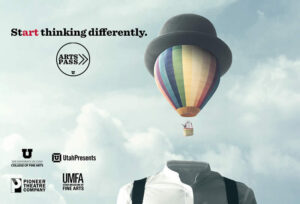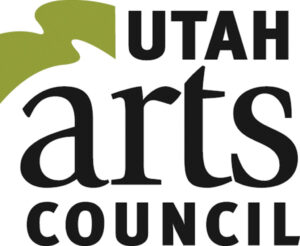Alexander Stanfield
Utah isn’t known for its arts scene – aside from a couple of collectives, a handful of museums, and an occasional festival, Utah lacks much of the appeal held by the art juggernauts in the States. Unlike those heavy hitters, tourist art is a big player in Utah’s art market; the prairie/mountain landscapes or the oversaturated prolonged exposures of some natural phenomenon – maybe a cowboy or two on their ranch, and don’t forget the fauna and flora. This is part of Utah’s identity, for better or worse. Utah has no shortage of breathtaking wilderness to inspire artists of any kind. Lack of inspiration isn’t Utah’s problem. Lack of infrastructure and opportunities to nurture and maintain many of its creators plagues what could be a vibrant arts community. Utah is victim to a self-destructive mentality, a ‘why pay someone when I can get someone else to do it for free’ state of mind. Even in Salt Lake City, where there is the highest concentration of venues, the amount of properly paid positions for those in the arts is, frankly, depressing.
Those who choose the academic side of the arts in Utah are presented with a similar, and arguably more difficult decision. With only three four-year universities in Utah, with only the University of Utah offering a PhD in Music, there is a looming low ceiling for those who’d want to pursue their academic possibilities within Utah. Each university has an associated museum or gallery, but many of the opportunities they offer are only available to students, not those entering the professional sphere. A lucky few that obtain the coveted password and gain entrance to one of the few arts institutions are provided with the means to stay in Utah. The rest, each through their own agency and for their own reasons leave for greener pastures.
That isn’t to say the training received from these programs isn’t noteworthy. In fact, there are highly respected historians, studio artists and professors at each university. I can personally attest to the diverse faculty and depth of knowledge within the University of Utah’s art and art history department, as I received my Bachelor’s and Master’s degrees there. However, it would be an understatement to say that the art history department was low on the funding totem pole; small, and overlooked comparatively to other discourses at the University of Utah. The main building is a cement bunker from the brutalist 1960s, which has a certain charm, but it was clear where the money went when you visited SJ Quinney College of Law or the Warnock Engineering building. The connection between namesake and funding gains a new layer knowing that there is a Marva and John Warnock Artist in Residence program, an opportunity only open to visiting artists, but no namesake to the department’s building.
There are certainly opportunities for academics and artists while they are students. But more often than not, those opportunities dry up once you leave the education system they are tied to. As a student, if you didn’t plan, or were not sure about going for the next level of degree, there wasn’t much direction given. You were told about job opportunities, what field your degree fit in, options you could take but not necessarily how to effectively apply what you had learned. I was taught about the de-Marxification of the American petty bourgeoisie, but not about how to network amongst museum staff to gain the employment I sought.
I had a semester internship at the Utah Museum of Fine Arts during my undergrad with the Campus Outreach department. It was a beneficial learning endeavor where I gained great experience, connected with professionals and even created a version of Salt Lake City’s Gallery Stroll on the University’s campus. It was great, but nothing came of it aside from the museum staff knowing my name and an extra line on my resume. No door was ever presented to me to continue work with the institution. It was an “Alright…thanks…bye” kind of exit. I do not regret any part of that internship, and you need to put in the proper work to receive the right job, but it stings when you’re told internships are how doors to jobs open up, and then there is no door.
As an art history graduate, it was heavily implied, and even said bluntly at times, that I would need to continue my academics if I wanted to enter the professional field. This is something I struggled with and came to terms with in my own time. When I finally decided that it was indeed what I wanted, I applied to grad school at the University of Utah because I developed useful connections within the department. I had a two month internship during the interim between my Bachelor’s and Master’s program, once again at the UMFA but this time with Development and Services. I gained even more experience with fundraising, event planning, and how to engage with donors and members. I even helped plan an exhibition gala. And yet again, after it had run its course, I was in the same situation. Another great experience, but it was clear that the door was shut behind me once the internship was over.
I would argue that the expectations, course work, and requirements of that art history department could go pound-for-pound with any art history department. Grad students are provided with the opportunity to be a teacher’s assistant, student instructor, work on research projects, receive funding for travel and grants, and to choose their desired path of research and the appropriate advisor to guide them. In the interest of pursuing museum work after I graduated, I chose to create an exhibition catalog in the hopes it would show my skills and ability to produce novel and engaging research. I was given high praise for what I produced but to this day it sits on the shelf gathering dust. And that is the most demoralizing part. Like many MA students, I put everything I could into my project, spent countless hours looking over red marks and rereading what I had already reread, stressing over the tiniest details, but I couldn’t find a platform to share my work outside of the seminar room. The three colleagues I was closest to during my MA were all subjected to similar pressure, with two of them leaving Utah to pursue their PhD aspirations. There is a massive disconnect between the arts on campus and the arts in the public sector. If Utah wants to keep the product of its education system it needs to do a better job of providing opportunities and reaching out, with reasons that entice us to stay.
My experience isn’t singular or unique. Many others have struggled, and will continue to struggle to develop roots here in Utah until change is implemented. Some tough it and even fewer not only add to the arts scene and culture in Utah, but make a living as well. Many like myself have to leave Utah to seek out more opportunities. I initially left Utah for reasons outside of career aspirations, but it ended up being the best thing to happen to me concerning my career. I encountered opportunities that wouldn’t have been possible staying in Utah and now my career within the arts has evolved into something I would have never anticipated.
I now consider myself to be part of ‘the returned,’ the individuals who wanted to contribute to the arts here in Utah but weren’t able to until after they had left. For most, the idea of staying in a place where you can’t make a living isn’t an option, especially if you know that you could elsewhere. It doesn’t help that the art curriculums we are constantly enveloped in refer to the very places that so many individuals relocate to – because we are conditioned to do so. The only references we hear or read about Utah are just to land art, prehistoric images, and the occasional encounter with a local artist. A very different discussion compared to the plethora of references to New York City and Los Angeles. If Utah wants to be a luring force for the arts it needs to act like it wants it. That is the mentality that got Los Angeles and New York City to where they are today, even if it was a fake-it-till-you-make-it persona at times. If Utah wants to contend with, not copy, art scenes like these then it needs people and institutions with the same mentality so that it can capitalize on what it has and what it does well. There is, of course, a daunting hurdle, funding. Utah’s Arts Council is one of the longest running collectives of its kind in the States but it hasn’t received the financial nourishment it needs. However, there may be hope on the horizon. Gov. Herbert proposed a new budget for Utah in FY20 (ed: Fiscal Year 2019-2020) that allocates more money for cultural organizations. In addition to the $1,000,000.00 already promised, the proposed legislation would provide a nearly six-fold increase in funding. We’ll have to wait and see if the Utah legislature feels that these nonprofit organizations are indeed worthy in their eyes. I will speak on the behalf of artists, academics, and creators alike here in Utah; give us reasons to stay that allow us to stay.
Volume 35 no 1 September / October 2020

This submission deserves a Post Script addition. I wrote this piece back in March as the COVID pandemic was on the rise. Many unknowns were still at hand and I could not have guessed the current state of affairs we now exist in. The hierarchy of priorities has shifted, crumbled, and is still under construction for the future. Many individuals in the Arts community in Utah believe that stability is a glimmer, but a return to prosperity is years away. As Utah begins to plan for the post-pandemic rebuild process, and it will be a long journey, it is the perfect opportunity to reassess what it truly values. Will the Arts, an industry that has suffered greatly, be given the support and vitality it needs to return and flurish? Or will it continue to receive the scraps of consideration from Utah’s elected body?
Alexander Stanfield